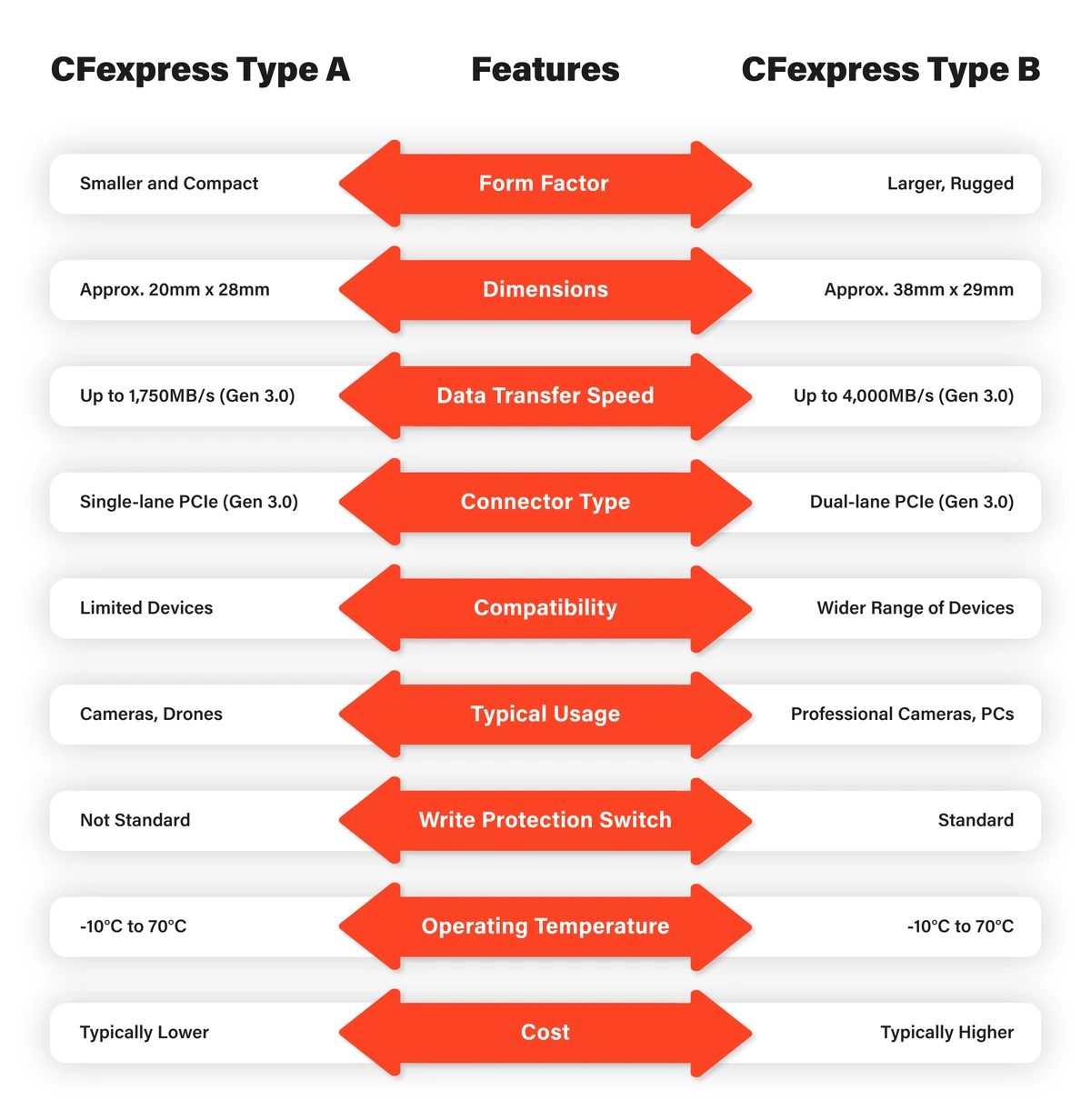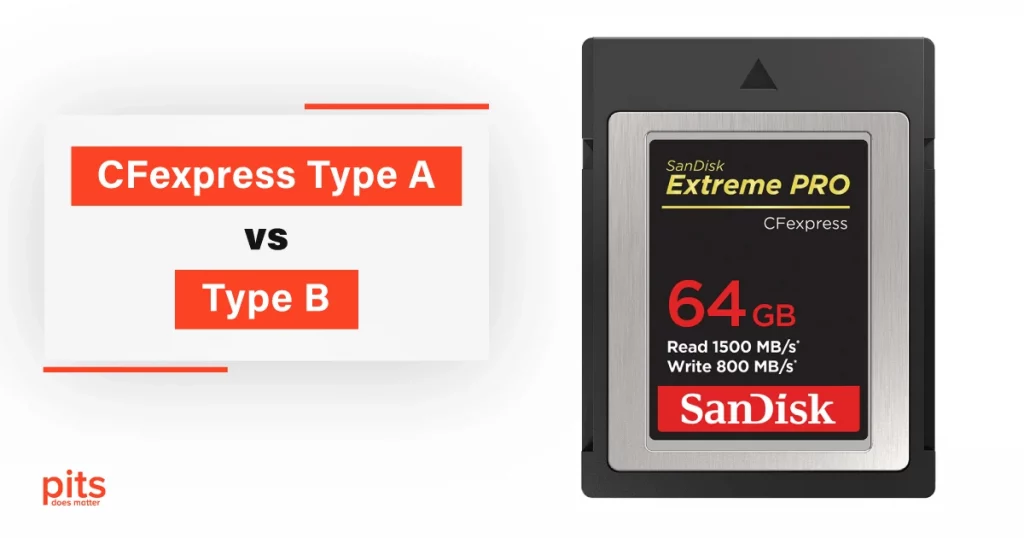When it comes to memory cards for cameras, CFexpress has been making waves in the photography and videography world. It promises blazing-fast to read and write speeds, making it ideal for professional use. However, there are two main formats to choose from: CFexpress Type A and CFexpress Type B. In this article, we will dive deep into the differences between these two formats, their applications, and how they compare to other memory card options.
Understanding CFexpress Formats
CFexpress is a relatively new memory card format that succeeds the XQD cards. It is designed to meet the increasing demands of high-resolution photography and raw video recording. CFexpress cards come in two main formats: Type A and Type B, each with its own set of characteristics.
CFexpress Type A
CFexpress Type A cards are the smaller and more compact of the two formats. They resemble the size of traditional SD cards but offer significantly faster speeds. These cards use a USB Type-C interface for connectivity, which is becoming more common in cameras and laptops.
One of the key advantages of CFexpress Type A cards is their size, making them suitable for smaller camera bodies. This format is particularly popular among mirrorless camera users who value portability without sacrificing performance.

CFexpress Type B
On the other hand, CFexpress Type B cards are larger and more robust. They feature a PCIe 3.0 interface, which offers even faster data transfer speeds compared to Type A cards. However, Type B cards are physically larger, resembling the XQD card format that they are intended to replace.
The larger size and PCIe 3.0 interface of CFexpress Type B cards make them suitable for high-end DSLR cameras and professional camcorders, where the physical size of the card is less of a concern compared to the need for maximum performance.
Speed Matters: Read and Write Speeds
One of the primary reasons photographers and videographers opt for CFexpress cards is their exceptional read and write speeds. These cards can handle large files, such as raw video, with ease. However, the performance differs between Type A and Type B cards.
CFexpress Type A Speed
CFexpress Type A cards typically offer read speeds of up to 1000MB/s and write speeds of around 800MB/s. These speeds are still significantly faster than what traditional SD cards can provide. It means smoother workflow, faster data transfer, and quicker access to your photos and videos.
CFexpress Type B Speed
CFexpress Type B cards take the speed game to another level. With read speeds of up to 2000MB/s and write speeds reaching 1700MB/s, they are the go-to choice for professionals working with high-bitrate raw video and high-resolution images. These speeds ensure minimal buffering and reduced waiting times during file transfers.
Application in Cameras
The choice between CFexpress Type A and Type B largely depends on your camera’s compatibility and your specific photography or videography needs.
CFexpress Type A for Portability
If you own a compact mirrorless camera or you prioritize portability and versatility, CFexpress Type A cards are a great choice. These cards are designed for smaller camera bodies and are perfect for on-the-go shooting. They are also compatible with the USB Type-C interface, which is increasingly common in modern camera designs.
CFexpress Type B for Maximum Performance
Professional photographers and videographers using high-end DSLR cameras or camcorders benefit from CFexpress Type B’s top-tier performance. The PCIe 3.0 interface ensures the fastest possible data transfer rates, which are essential for capturing raw video and handling large image files without interruption.
Compatibility with Type C Cards
One of the advantages of CFexpress is its backward compatibility with XQD cards, which can be particularly useful for photographers who are transitioning to the new format. Both Type A and Type B CFexpress cards share this compatibility, making it easier to switch between formats.
CFexpress vs. SD Cards
While CFexpress offers impressive performance, traditional SD cards are still widely used due to their availability and affordability. It is important to note that CFexpress and SD cards are not interchangeable, so compatibility with your camera is crucial.
CFexpress offers faster read and write speeds, making it suitable for professional use, especially when working with high-resolution images or raw video. However, SD cards may be sufficient for everyday photography needs, and they remain a cost-effective choice for many photographers.
Minimum Sustained Write Speeds
When shooting raw video or high-resolution photos, the minimum sustained write speeds of your memory card become crucial. CFexpress Type B cards excel in this department, ensuring that data is written to the card consistently at high speeds.
This is essential for avoiding dropped frames in video recording and maintaining a smooth workflow in photography.
CFexpress Type A cards, while still fast, may not offer the same level of sustained write speed as their Type B counterparts. Depending on your camera and the specific shooting scenario, this difference may or may not be significant.

Firmware Updates and Card Readers
Before investing in CFexpress Type A or Type B memory cards, it’s essential to check for firmware updates for your camera. Some older models may require updates to ensure compatibility with CFexpress cards.
Additionally, make sure you have a compatible card reader that supports the CFexpress format. These readers can be USB-C or Thunderbolt 3-based, depending on your computer’s capabilities. Without a suitable card reader, you won’t be able to take full advantage of the card’s speed during file transfers.
CFexpress Type A vs B in Summary
In summary, CFexpress Type A and Type B offer distinct advantages and are suited to different types of camera systems and shooting needs:
CFexpress Type A:
- Compact and portable
- Suitable for mirrorless cameras
- USB Type-C interface
- Excellent read and write speeds for most users
- Ideal for photographers on the go
CFexpress Type B:
- Larger and robust
- PCIe 3.0 interface for maximum performance
- Best for high-end DSLRs and professional camcorders
- Exceptional read and write speeds for demanding tasks
- Perfect for raw video and high-resolution photography
Ultimately, the choice between CFexpress Type A and Type B depends on your camera, your shooting style, and your budget. Whichever format you choose, CFexpress cards are a significant step up from traditional SD cards when it comes to speed and performance.
With the ability to handle raw video and high-resolution images with ease, CFexpress is the future of memory cards for professionals. As technology continues to evolve, we can expect even faster speeds and greater capacities in the world of memory card formats. So, whether you’re capturing stunning landscapes or shooting cinematic raw video, CFexpress has you covered.
Frequently Asked Questions
What are CFexpress Type A and Type B cards?
CFexpress Type A and Type B are two different formats of CFexpress memory cards. They are designed to provide high-speed data transfer and storage solutions for cameras and other devices. Type A is smaller, resembling an SD card, while Type B is larger and more robust.
What are the key differences between Type A and Type B?
The primary differences lie in their physical size and speed. Type A cards are smaller and offer slightly lower read and write speeds compared to Type B. Type B cards, which are larger and provide higher data transfer rates, making them ideal for professional-grade cameras and raw video recording.
Which format should I choose for my camera?
The choice depends on your camera’s compatibility and your specific needs. If you have a compact or mirrorless camera and value portability, Type A might be the better choice. If you have a high-end DSLR or need maximum performance for tasks like raw video recording, Type B is more suitable.
Are CFexpress Type A and Type B compatible with older XQD cards?
Yes, both Type A and Type B CFexpress cards are backward compatible with XQD cards. This means you can use CFexpress cards in cameras that previously supported XQD cards, providing an upgrade path for photographers with older equipment.
